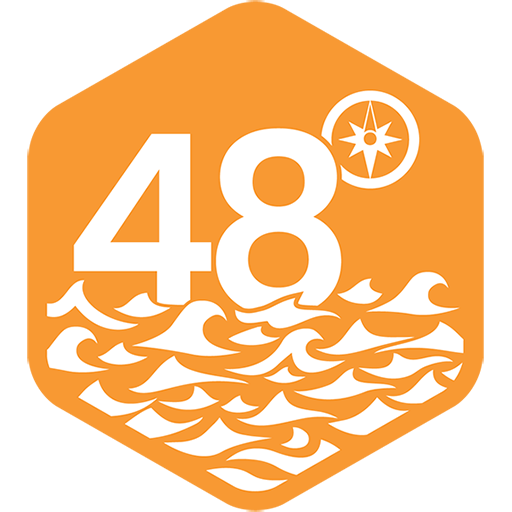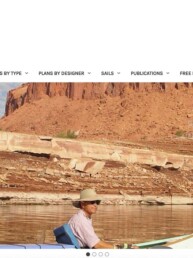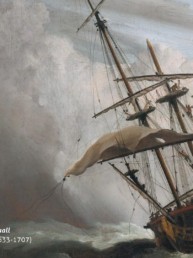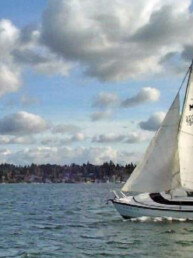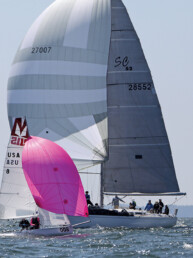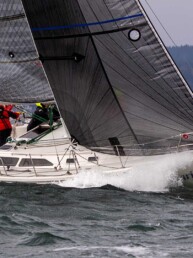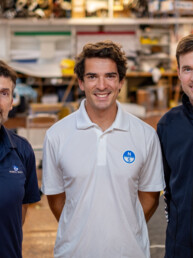Team Puget Sound Navigation Company, composed of Molly and Michael Karas and Anthony Boscolo, won the WA360 adventure race and smashed the course record with an elapsed time of 2 days, 18 hours, and 24 minutes. Anthony and Michael each are R2AK steak knife winners from 2016’s Team Jungle Kitty. Puget Sound Navigation Company sailed the Karas’s Gougeon 32, Incognito, which they purchased from fellow Port Townsender, Russell Brown (who set the solo R2AK record on the boat in 2018). Molly, Michael, and Anthony were gracious enough to sit down with 48° North for an interview after their victory.
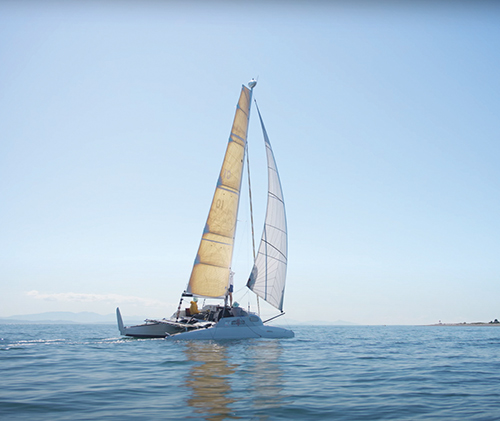
Who was the lead instigator on this team? And how did it all come together?
Michael: I think it was Molly.
Molly: I was bummed I couldn’t do R2AK when they did it. I pushed for getting a Gougeon 32 with the thought that it would be a cool boat to do one of these races on. Something we could race and get where we wanted to quickly, but you could still cruise it. As we narrowed in on the Gougeon, Russell [Brown] started helping us look for one. Eventually, he said, “I’m going to work on my next boat project, and I’m ready to sell.” Luckily, by that time we had our daughter Mara and that was a big draw for Russell—to have family in the boat. Once we got this boat, we were like, “Well, it already has a pedal drive, so…”
What about the prospect of jumping into a lengthy adventure race excited you—Anthony and Michael to pursue it for the first time since R2AK, Molly to do it for the first time?
Michael: The timing was right. We knew a lot of the waterway already.
Anthony: Your cell phone works most of the time. The safety net is there.
Molly: We have a toddler. It was very doable for us to just hop in, take off a few days from work, and the logistics were easy—we left from home and we came back to home. So, why not do this race? It’s kind of dumb not to. It’s like a little vacation. There’s no energy to think about anything else for a few days. And I was stoked to hang out with these guys and have a break from toddler life.
Michael: We all really trust each other in sailing, and we know our levels are fairly comparable. Maximizing the boat’s potential, that focus and trying to see what you can do is fun for me.
Anthony: I have really fond memories of Race to Alaska. There’s this special feeling with these events that Northwest Maritime puts on, and the fact that there’s people tracking you, and you’re sailing by random houses and people holler at you. It just feels comfortable and interesting, and you also feel kind of like a star when someone shows up in a powerboat to interview you. The community gets around the event, it’s very different from your everyday weekend racing event. That vibe is so unique, and it makes it really special and fun.
Molly: Among the competitors, too. What race do you go to and everyone is cheering on all the other race boats? You’re crossing paths constantly because you have to do 180s, and you cheer for your competitors, or even ask for help.
Did you have a lot of time in the boat before the race?
Molly: Anthony had been on it cruising for a cocktail cruise only twice before the start! He had less than two hours on the boat before WA360.
Anthony: I had more time working on the pedal drive than sailing the boat before WA360.
Molly: We’ve done some little cruises with Mara, and Race to the Straits two years in a row.
After lead changes through the first day, you pulled away at night. What happened?
Molly: Yeah, it was pretty challenging that night. We were fighting hard currents.
Michael: And no wind.
Molly: At one point, Narrows Minded passed us at like 5 knots and we were literally standing still—it looked like they were motoring, silent, they had some super secret sail up. We started pedal sailing with this tiny little zephyr of wind, and caught them after a couple of hours. I went to bed and the boys pedaled really hard. We were able to round the Olympia mark first and have good current for like an hour and legged out before it switched again.
Anthony: That leg down to the shoal when Mike and I were up, we were close-hauled with a zephyr of breeze with our big screecher, trucking down there.
Michael: Trucking being a relative term. There was another section on the way back up when Molly and I were pedal sailing too. We had a super straight run for a mile and a half, and I’m pretty sure that was a very fast section for us, going like 4 knots.
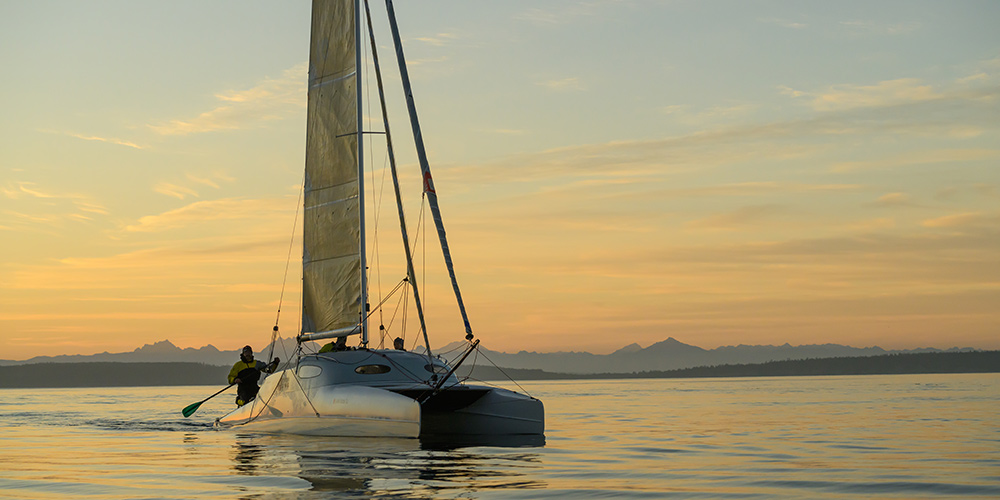
What portion of the race were you just pedaling, versus pedal sailing, versus just sailing?
Molly: We did about 24 hours in the pedals. Of that, there were at least 15 hours that was just pedaling.
Anthony: I did some rough math, and we did close to 60 miles with the pedal drive in the water.
Molly: And all of that was against current. I don’t think we pedaled with the current, ever.
How would you describe the level of effort on the pedals?
Molly: If someone is pedaling and we were not sailing, then someone was paddling too. We could go 4.5 knots for a very short time; that was our high effort top speed. Otherwise, the guys were faster pedaling and could sustain 3 knots.
Michael: If someone was paddling or if you were sailing, it just reduced the load on your legs.
Anthony: There were times when we had to rotate out of pedaling because we were exhausted, and then there were times when we were casually pedaling—like in the Swinomish Channel, we had to go a long way. I was still definitely sweating, still in my underwear in the middle of the night, but not at my limit.
Molly: We were so gross (laughing).
Tell us about your watch schedule. Was it rigid or flexible?
Molly: We started four hours on, two hours off. Toward the afternoon of the second day, we were all getting pretty tired so we changed it to three hours off to try to get more sleep. At that point, the boys had about two hours of sleep each, and I had maybe four hours. There was a lot of resting, but there wasn’t a lot of sleep. You’ve been exercising and sweating, and then you’re just supposed to go to sleep? Switching to three hours helped.
On the last night, it turned out to be pretty windy and gusty in the San Juans. In the Gougeon, that can be pretty peppy, so you want to see the puff. At night, you can’t see it coming. There’s a very fine tipping point between we’re heeled and we’re capsized. It was pretty stressful. After that stretch, Mike laid down in his drysuit and life jacket on the spinnaker and just passed out and slept for three hours. He came up, Anthony went down and slept like the dead. So they each got a little sleep at the very end, and finished the race with maybe 6 hours total. I think we were still functioning, but we were tired. If we had gone one more day, I think we all would have started sleeping really well.
Any long race with a lot of physical effort, you’re going to have some lows. When were you feeling low, and how did you push through?
Anthony: I was feeling bad for Michael because he had this terrible cough.
Michael: I woke up sick on Thursday and was questioning if we could race, but by Saturday morning’s start I was ok.
Anthony: But that was my low moment, feeling bad for him and wondering, “Is this going to work with Molly and I getting around this course with Michael’s dead weight?”
Molly: My only low in the race was when Narrows Minded went past us in the South Sound. That was like, “Man, this isn’t going to happen.” But we just kept pedaling and paddling. We were exercising so hard, I never felt tired at any point the first two nights, which is weird. I was waiting to feel exhausted, but didn’t get tired until the last night. I had fun the whole time, minus that little bit.
Anthony: I was a relatively late addition to the team, and I was really in this just for the fun. I wanted to go do this R2AK-style adventure. And I was really into the idea of getting to go sail the Gougeon and tweak around with it, because it’s such a quirky little boat. I knew this was going to be a blast! I didn’t really think we were in it to win it, especially after walking the dock and seeing a few of the racecars out there. On the first day going down the Sound, the Seacart passed us like we were stopped. From a racing perspective, I was like, “Ok, I’m going to check that emotion off the list. We’re going to try hard, we’re going to have a good time, but we’re probably not fighting for the win.” After a while when they got stuck on the bottom side of Vashon for a long time, my mentality was in-between whether to be emotionally attached to trying to win or just having a good time—and it was actually kind of a nice place to be. I stayed pretty high the whole time.
Michael: I had a few lows, because I was so exhausted from being sick, especially the last hour of my watches throughout. I probably didn’t eat as much as I normally do and it’s really energy driven for me. And when I’m really tired, I lose confidence in sailing and things like that.
Molly: I don’t think any of us were like, “We’ve got this!” at any point in the race. Until we could see Port Townsend. But after watching Broderna get swept out to sea in the first WA360… anything can happen.
What did you learn about your boat over the course of this race?
Molly: Anthony taught us about a secret upwind mode, you can sail upwind with the screecher. It saved our race.
Anthony: I mostly figured this out from the Russell Brown trimaran that Haley and I bought last year, and it has a screecher that’s really similar to the one that’s on the Gougeon. When it’s super light, you need some more sail area to get it going. Messing with halyard tension and trimming the screecher really hard works, and I was curious to see if it would work on the Gougeon too. You can take it pretty much close-hauled—maybe a couple of degrees off, but way faster.
Molly: The pole on the Gougeon can go anywhere, it’s got unlimited range. It’s hard to replicate settings, but what we found to work was pull down as hard as you could on the leeward side and tighten the pole there, and then tighten the luff of the sail.
Michael: Basically adjusting the sheeting angle by adjusting where the tack is.
Molly: That was what we did from Lummi all the way to Point Roberts in our magical super straight layline going mach 10 on glassy water.
Anthony: That was good sailing.
What did you learn about the Sound?
Molly: I’d never been so many places, that was really cool. Never done the Swinomish and come out the Bellingham route. Never been to Point Roberts. Never gone under the Narrows.
Anthony: I learned that the stereotypes are real, they just got reinforced for me. Like the South Sound—everyone knows there’s no wind down there, and there’s no wind down there. The current is all over the place, and you gotta watch out for it.
Michael: We were very cognizant of the currents. There were some really interesting forecasts that didn’t pan out. It got so windy in Colvos on the way back up, I’ve never seen it so windy there. And it was totally unexpected. Probably 20-25 knots.
Anthony: There’s some interesting little microclimate things going on. If you lived there you’d know, “Oh the breeze always blows from that direction,” or whatever. Just passing through, I don’t know if it’s a regular thing or not, like we sailed in a weird east breeze off of Whidbey that forecasts weren’t calling for. You’ve got to keep your eyes up, don’t always trust the models.
Molly: Even though there was no wind a lot of the time, it was a really pretty time to be doing this. The moonsets were really early, there were stars every night. The sunrises every morning were insane. Even though the coastline is really different between the South Sound, the inside of Whidbey, the Swinomish is really different, Point Roberts, the San Juans—everyone along the way is one big community, cheering for us and sending us support. Everything is really connected.
Any other lasting highlights?
Molly: It was so cool how much cheering there was on shore.
Michael: Random encounters in the middle of the night.
Molly: People would be waving flashlights at us in their houses at night so we know that they’re cheering. We got binoculars out more for looking at shore to see what people were yelling at us than anything else. For me, it was just taking it in, and realizing we’re doing this really cool race and we have all these people supporting us, and we’re doing it with a bunch of crazy people who think that Type-II fun is a good thing. The paddle crews really like Type-II fun. Boogie Barge… they are machines! Or anybody that did it solo. We gained a lot of appreciation for what Russell did on this boat in Race to Alaska. Because we live here, we were able to bring our daughter down and cheer on a few teams at the finish.
Anthony: That’s also a fond memory from Race to Alaska. In Ketchikan, you’re going down to greet and cheer teams at the finish, and then go get a beer afterward. This reminded me of that. It’s really fun to welcome others and hear their stories.
Molly: I wanted to go back out again, I thought we did it too fast, we missed out on the fun of the longer adventure. We also missed out on some gnarly conditions, we had it easy. The teams that finished behind us had some hard decisions to make—a bunch of gale warnings, multiple days in a row. I mean, it was fun to do it fast too.
For full results: wa360.org
Editor
48° North Editors are committed to telling the best stories from the world of Pacific Northwest boating. We live and breathe this stuff, and share your passion for the boat life. Feel free to keep in touch with tips, stories, photos, and feedback at news@48north.com.
